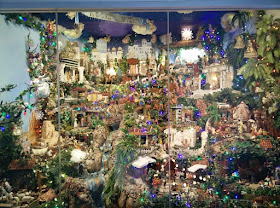Around this time last year, my husband and I were on vacation in Arizona. We both love Arizona -- for it's incredible beauty and history, as well as for the lovely people who live there. We met and fell in love while attending college in Arizona, and it was really special to revisit some of the places that were important to us.
In the starry night sky, there are herald angels and puffy clouds.
Everywhere, there is whimsy. El Nacimiento tells the story of the hope of the Christ child throughout the ages in a way that delights the eye.
If you travel to Tucson, at any time of year, I recommend the Tucson Art Museum and La Casa Cordova. If you travel to Tucson during the holidays, El Nacimiento is not to be missed.
If you enjoyed learning about this Mexicn folk art custom, you might also enjoy this post about a Swedish woven star folk art tradition.
I love handmade, human scaled architecture, so we visited La Casa Cordova, part of the Tucson Museum of Art complex. What a delightful surprise to find El Nacimiento (the creche) on display in La Casa Cordova.
La Casa Cordova is a very old adobe house in what had once been the walled presidio area of the city.
La Casa Cordova is a very old adobe house in what had once been the walled presidio area of the city.
The interior of the house was simply and humbly decorated for the holiday with tinsel and understated tissue paper flowers.
Then we stepped into the room that housed El Nacimiento, and wow! This was one of the largest nativity scenes I have ever seen. How I lived all those years in Arizona, and never once visited El Nacimiento is beyond me.
This nativity is the creation of Mexican American folk artist Maria Luisa Tena. Over many years, Maria created the display in memory of her mother, who taught her the Mexican tradition of creating nativity scenes.
The diorama depicts typical Mexican village scenes, Old Testament scenes, and, of course, the Nativity.
The detail of El Nacimiento are simply delightful, ranging from street market scenes to kitchen scenes to swan swimming in a waterfall fed pool.
There are pretty lights, foliage, wise men, and adobe houses.
There are farm animals, children, Bible characters, and villagers.
Everywhere, there is whimsy. El Nacimiento tells the story of the hope of the Christ child throughout the ages in a way that delights the eye.
If you travel to Tucson, at any time of year, I recommend the Tucson Art Museum and La Casa Cordova. If you travel to Tucson during the holidays, El Nacimiento is not to be missed.
If you enjoyed learning about this Mexicn folk art custom, you might also enjoy this post about a Swedish woven star folk art tradition.
If you enjoyed this post, please subscribe to House Revivals in the sidebar, so you won't miss the fun projects we have planned. Find us on Facebook, too, so you can catch all the "in between" stuff, and see what I'm working on throughout the week on Instagram. Feel free to link today's project to all your favorite social media sites.
Thanks for stopping by!
Amanda











